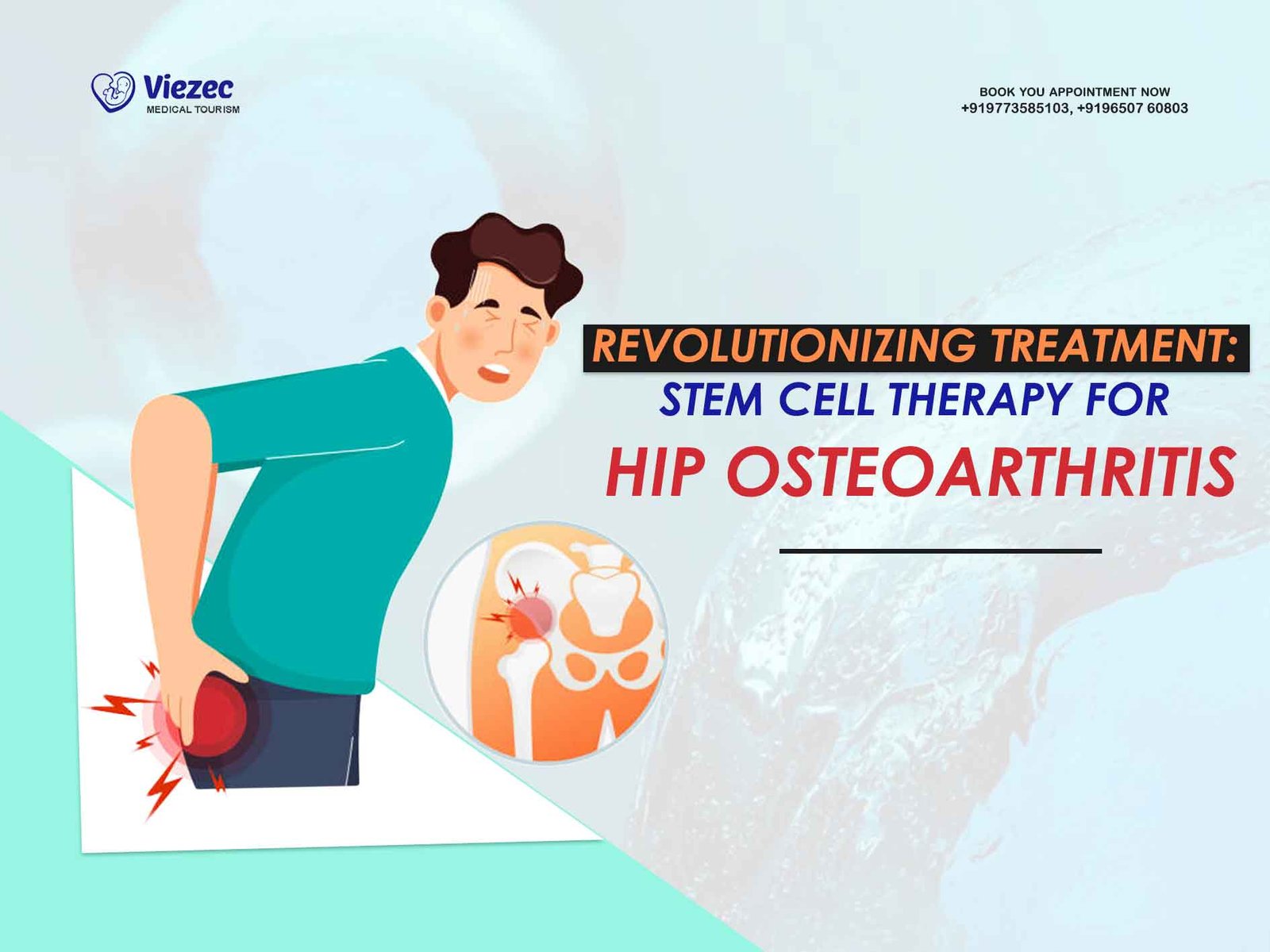Hip osteoarthritis is a debilitating condition characterized by the progressive degeneration of cartilage in the hip joint, leading to pain, stiffness, and reduced mobility. As one of the most common forms of arthritis, it significantly impacts the quality of life for millions of people worldwide. Traditional treatment approaches often focus on symptom management or surgical interventions like total hip replacement surgery. However, these methods have limitations in terms of efficacy, durability, and invasiveness. In recent years, there has been growing interest in exploring alternative therapeutic solutions, with stem cell therapy emerging as a promising avenue for revolutionizing the treatment of hip osteoarthritis.
Understanding Hip Osteoarthritis: Causes and Symptoms
Hip osteoarthritis develops as a result of various factors, including aging, genetics, obesity, joint injuries, and repetitive stress on the hip joint. Over time, the protective cartilage that cushions the ends of the bones wears down, leading to friction, inflammation, and structural changes within the joint. Common symptoms include pain, stiffness, swelling, and decreased range of motion, which can significantly impair an individual’s ability to perform daily activities and negatively impact their overall well-being.
Impact of Hip Osteoarthritis on Quality of Life
The impact of hip osteoarthritis extends beyond physical discomfort, affecting psychological health, social interactions, and overall quality of life. Chronic pain and limited mobility can lead to depression, anxiety, and social isolation, further exacerbating the burden of the disease. As the condition progresses, simple tasks such as walking, climbing stairs, or getting in and out of chairs become increasingly challenging, diminishing independence and overall satisfaction with life.
Traditional Treatment Approaches for Hip Osteoarthritis
Non-Surgical Interventions: Medications and Physical Therapy
Non-surgical treatments for hip osteoarthritis often involve a combination of pain medications, such as nonsteroidal anti-inflammatory drugs (NSAIDs) and analgesics, to alleviate symptoms and improve function. Physical therapy and exercise programs may also be recommended to strengthen muscles, improve flexibility, and maintain joint mobility. While these approaches can provide temporary relief, they do not address the underlying cause of cartilage degeneration and may not be sufficient for long-term management.
Surgical Options: Total Hip Replacement Surgery
In cases where conservative measures fail to provide adequate relief, surgical intervention may be necessary. Total hip replacement surgery involves removing the damaged joint surfaces and replacing them with artificial implants made of metal, plastic, or ceramic components. While this procedure can effectively relieve pain and restore mobility, it is invasive, irreversible, and associated with risks such as infection, implant failure, and prolonged recovery time. Additionally, younger patients may face concerns about the longevity of the implants and the need for future revisions.
Limitations of Current Treatments and the Need for Innovation
Challenges in Traditional Treatment Approaches
Despite advances in medical management and surgical techniques, current treatments for hip osteoarthritis have several limitations. Non-surgical interventions offer symptomatic relief but do not halt disease progression or promote tissue regeneration. Total hip replacement surgery, while effective in severe cases, is associated with inherent risks, complications, and limitations, particularly in younger, more active patients. Furthermore, there is a growing recognition of the need for less invasive, more targeted therapies that can address the underlying pathophysiology of the disease.
The Search for Alternative Therapeutic Solutions
Given the limitations of conventional approaches, there is a pressing need for innovative therapies that can modify the course of hip osteoarthritis and restore joint function without the need for major surgery. Stem cell therapy has emerged as a promising avenue for regenerating damaged cartilage, reducing inflammation, and potentially delaying or avoiding the need for joint replacement. By harnessing the regenerative and immunomodulatory properties of stem cells, researchers aim to provide patients with safe, effective, and long-lasting treatment options.
Introduction to Stem Cell Therapy
What Are Stem Cells and How Do They Work?
Stem cells are unique cells with the remarkable ability to differentiate into various specialized cell types and regenerate damaged tissues. They can be found in different sources, including bone marrow, adipose tissue, and umbilical cord blood. In the context of osteoarthritis, mesenchymal stem cells (MSCs) have received considerable attention for their capacity to differentiate into chondrocytes, the cells responsible for producing and maintaining cartilage.
Types of Stem Cells Used in Therapy
Stem cell therapy for hip osteoarthritis may involve the use of autologous (from the patient’s own body) or allogeneic (from a donor) stem cells. Autologous stem cells are typically harvested from the patient’s bone marrow or adipose tissue, processed, and then injected directly into the affected joint. Allogeneic stem cells, on the other hand, are obtained from a compatible donor and can be used off-the-shelf for treatment. Each approach has its advantages and considerations, including immune compatibility, cell yield, and regulatory requirements.
Mechanisms of Stem Cell Therapy for Hip Osteoarthritis
Regenerative Potential of Stem Cells in Cartilage Repair
One of the primary mechanisms by which stem cell therapy exerts its therapeutic effects in hip osteoarthritis is through cartilage repair and regeneration. MSCs have the ability to differentiate into chondrocyte-like cells, which can populate and repair damaged cartilage tissue. Additionally, stem cells secrete various growth factors, cytokines, and extracellular matrix components that create a conducive microenvironment for tissue healing and remodeling.
Immunomodulatory Effects on Inflammation and Joint Degradation
In addition to their regenerative properties, stem cells possess potent immunomodulatory capabilities that can help mitigate inflammation and immune-mediated joint damage in osteoarthritis. By suppressing pro-inflammatory cytokines, modulating immune cell activity, and promoting tissue repair pathways, MSCs contribute to the resolution of joint inflammation and the preservation of cartilage integrity.
Clinical Evidence Supporting Stem Cell Therapy
Review of Clinical Trials and Studies
Numerous preclinical and clinical studies have demonstrated the safety and potential efficacy of stem cell therapy for hip osteoarthritis. Early-phase trials have shown improvements in pain, function, and cartilage quality following stem cell treatment, with some patients experiencing sustained benefits over the long term. While larger, randomized controlled trials are needed to confirm these findings and establish optimal treatment protocols, the accumulating evidence suggests a promising role for stem cell therapy in the management of hip osteoarthritis.
Patient Outcomes and Long-Term Effects
Long-term follow-up studies have provided valuable insights into the durability and safety of stem cell therapy for hip osteoarthritis. While individual responses may vary, many patients have reported sustained improvements in pain relief, joint function, and quality of life following treatment. Importantly, stem cell therapy appears to be well-tolerated, with few serious adverse events reported in clinical trials. Continued monitoring and research are essential to further elucidate the optimal timing, dosing, and patient selection criteria for maximizing treatment outcomes.
Procedure and Administration of Stem Cell Therapy
Pre-Treatment Evaluation and Patient Selection
Before undergoing stem cell therapy, patients undergo a comprehensive evaluation to assess their suitability for treatment. This includes a thorough medical history review, physical examination, imaging studies (such as X-rays or MRI), and laboratory tests. Patient selection criteria may vary depending on factors such as disease severity, age, overall health status, and treatment goals. Candidates with advanced osteoarthritis, significant joint deformity, or unresolved medical issues may not be suitable candidates for stem cell therapy.
Stem Cell Harvesting and Processing Techniques
The harvesting of stem cells typically involves minimally invasive procedures such as bone marrow aspiration or liposuction. Bone marrow-derived MSCs are obtained from the pelvic bone using a specialized needle, while adipose-derived MSCs are extracted from fat tissue through liposuction. Once harvested, the stem cells are processed in a laboratory to isolate and concentrate the desired cell population before being prepared for injection into the affected joint.
Injection Techniques and Targeted Delivery
The delivery of stem cells into the hip joint can be performed using various techniques, including ultrasound or fluoroscopy guidance to ensure precise placement. The cells may be injected alone or in combination with other substances such as platelet-rich plasma (PRP) or scaffolds to enhance their retention and regenerative potential. Post-injection, patients are typically monitored closely and may undergo rehabilitation or physical therapy to optimize outcomes and promote joint healing.
Safety and Efficacy Considerations
Assessing the Safety Profile of Stem Cell Therapy
Safety remains a paramount concern in the development and implementation of stem cell therapies for hip osteoarthritis. While stem cell-based interventions have shown promising results in early studies, there are important considerations regarding potential risks such as infection, tumor formation, and immune rejection. Close monitoring of patients, adherence to stringent quality control standards, and adherence to regulatory guidelines are essential to minimize adverse events and ensure patient safety.
Evaluating the Effectiveness and Durability of Treatment
In addition to safety, the effectiveness and durability of stem cell therapy for hip osteoarthritis warrant careful evaluation through rigorous clinical research. Randomized controlled trials with long-term follow-up are needed to assess treatment outcomes, compare different stem cell sources and delivery methods, and determine the optimal timing and frequency of injections. Patient-reported outcomes, radiographic assessments, and functional measures are important endpoints for evaluating treatment efficacy and guiding clinical decision-making.
Future Directions and Challenges
Advancements in Stem Cell Research for Hip Osteoarthritis
As our understanding of stem cell biology and regenerative medicine continues to evolve, ongoing research efforts are focused on optimizing stem cell-based therapies for hip osteoarthritis. This includes exploring novel cell sources, refining tissue engineering techniques, and enhancing the therapeutic potency of stem cells through genetic modification or combination therapies. Advances in biomaterials, imaging technologies, and delivery systems also hold promise for improving the precision and effectiveness of stem cell treatments.
Addressing Regulatory and Ethical Considerations
Despite the potential benefits of stem cell therapy, there are regulatory and ethical challenges that must be addressed to ensure safe and responsible translation into clinical practice. Regulatory agencies play a crucial role in establishing standards for product quality, manufacturing practices, and clinical trial oversight. Ethical considerations regarding patient consent, equitable access to treatment, and transparency in reporting research findings are also important for upholding ethical principles and fostering public trust in stem cell-based therapies.
Potential of Stem Cell Therapy in Revolutionizing Hip Osteoarthritis Treatment
Summary of Key Findings and Insights
In summary, stem cell therapy holds significant promise for revolutionizing the treatment of hip osteoarthritis by addressing the underlying pathology and promoting tissue regeneration. By harnessing the regenerative and immunomodulatory properties of stem cells, researchers aim to provide patients with safe, effective, and minimally invasive treatment options that can improve pain, function, and quality of life.
Looking Ahead: Implications for Clinical Practice and Patient Care
Looking ahead, the continued advancement of stem cell research and clinical trials holds the potential to transform the management of hip osteoarthritis and improve outcomes for patients worldwide. However, challenges remain in terms of standardization, scalability, and long-term monitoring of treatment effects. Collaborative efforts among researchers, clinicians, regulators, and industry stakeholders are essential for overcoming these challenges and realizing the full potential of stem cell therapy in revolutionizing hip osteoarthritis treatment.









